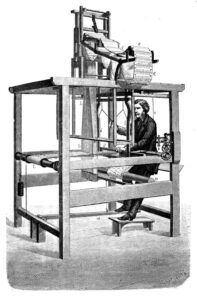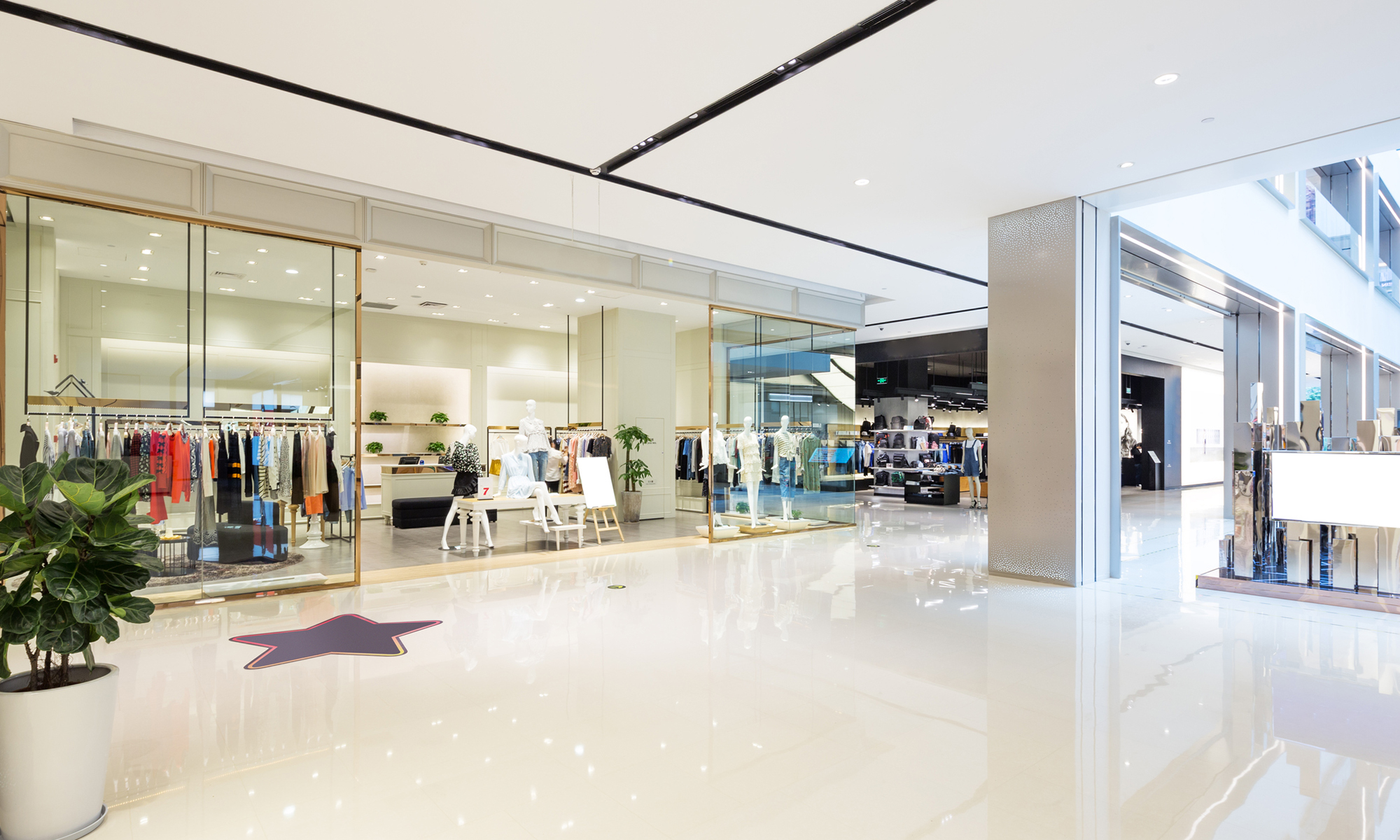Weaving fibers to form a fabric has been a part of human existence since ancient times. Weaving is the process of interlacing longitudinally oriented warp threads with horizontally oriented weft threads to form a woven fabric. Weaving is performed on a loom, a device arranged to hold warp threads under tension while allowing the weft threads to be sequentially added to them, to produce a fabric. The relative movement and positioning of the warp and weft threads during the weaving process results in a sequence of thread placements that together form a pattern in the finished fabric. To change patterns, the sequence of thread placements must be modified, a traditionally labor and time intensive process. Through the centuries, looms have had a variety of configurations, but their basic function has remained the same.
placements that together form a pattern in the finished fabric. To change patterns, the sequence of thread placements must be modified, a traditionally labor and time intensive process. Through the centuries, looms have had a variety of configurations, but their basic function has remained the same.
Loom technology has seen a variety of innovations throughout history in a continuous effort to make fabric production faster, easier, and more cost-effective. The Jacquard machine invented by French weaver Joseph-Marie Jacquard (born 1752 in Lyon, France) revolutionized the field of weaving. His invention, which uses punch cards to represent a desired sequence of thread placements during operation of the loom, greatly reduced the labor involved in the process of weaving. Jacquard designed a device that would be attached to a loom to control the placement of individual warp threads according to a pre-set progression of steps represented and controlled by a pattern of holes in each of a set of punch cards. This allowed looms to not only produce complex textile patterns such as brocade, damask, and lace, but also to be changed quickly from one pattern to another. By simply exchanging a first set of punch cards for a second set of punch cards, the loom could be reprogrammed to produce a new fabric pattern. Jacquard looms are used for weaving all sorts of intricate patterned textiles. They could be programmed to weave a single pattern fabric or a combination of patterns with different colors. Continue reading “Programming Fashion”
From Home-Made to Store-Bought Fashion
Fashion is a way of creating new and distinctive designs that can be worn by different people in different settings. It is often a reflection of the times in which it is created, but it can also be influenced by, technology, culture, even religion. Before the mid-19th century, most clothing was home-made. Occasionally, a village dressmaker was available to make a made-to-measure dress. The wealthy often employed seamstresses who dealt directly, and often exclusively, with their patron. The rapid mechanization of fabric production led to the appearance of ready-to-wear stores that provided the middle classes an opportunity to move away from home-made garments.
Aniline dye printed fabrics were used for many of the garments that were produced in this period. They were woven according to a manufacturing method that caused the dyes to run down the surface of the fabric. This made the garments more textured and interesting. The process created fabrics that contrasted with the smoother, lighter-colored cottons and linens that were also popular at the time. Aniline dyes could also be applied to other materials to give them a more sophisticated appearance. One example is aniline colored velvet which was very popular through the 1890’s. It was made in a range of colors, from soft pink to dark red and sometimes bright purple. The Aniline colored velvet was a soft, comfortable fabric that clung to the body, revealing the wearer’s shape, and giving it an attractive drape. It was especially popular for evening dresses. Velvet was made in a range of textures, from fine to coarse. It was usually trimmed with delicate embroidery, lace, ribbons and beading. Continue reading “From Home-Made to Store-Bought Fashion”
Color My World: Aniline Dyes in Fashion
The past centuries have seen a variety of cultural and technological shifts, and the fashion world has followed suit. These changes have also had a profound impact on the way we dress. In the 19th century, the commercialization of newly discovered aniline dyes for printed fabrics had a profound impact on fashion. The use of these synthetic dyes changed the way we colored fabrics, allowing manufacturers to scale up production. Aniline dyes made it easy for manufacturers to print on a wide range of fabric types all with consistent hue and tone of the color between batches. This allowed for the reemergence of the dyeing industry, which was formerly languishing because of its long dependency on expensive naturally derived pigments. Continue reading “Color My World: Aniline Dyes in Fashion”
From Coal Tar to Couture: The Discovery of Aniline Dyes and The Effect Upon Fashion
Around 1856 an 18-year-old British chemist named William Henry Perkin changed the world of fashion forever. He had been performing experiments seeking to replace the natural anti-malarial drug quinine. Instead of the colorless powder he had expected, he found that oxidizing aniline, a coal tar derivative, produced a reddish powder containing something far more exciting: an intense purple. Fashion would never be the same! This discovery led to the wide commercial availability of low cost, brightly colored fabrics that would be available to all. It also marked the beginning of a hugely profitable business. Continue reading “From Coal Tar to Couture: The Discovery of Aniline Dyes and The Effect Upon Fashion”
Blockchain and NFTs Are Smart, but Can They Revolutionise the Fashion Industry?
Following the worldwide disruption in retail due to COVID-19, sales of luxury goods are expected to grow as much as 25% in 2022. Much of this growth has been driven by e-commerce, with online sales totalling 23% of all luxury sales in 2020. Meanwhile, consumer sustainability demands have driven growth in luxury resale or rental markets, now worth an estimated $36 billion, while brands have expanded their reach into the brave new digital territory of the metaverse – the overlapping digital spaces in which we increasingly work, play, and consume.
Yet luxury’s digital embrace has been hampered by a concomitant rise in counterfeit goods in the physical and digital worlds. Is blockchain the solution?
To read the full text of this article co-authored by Duane Morris attorneys Cindy Yang and Kelly Bonner, please visit the Multilaw website.
News For Retailers: New California Law Requires Gender-Neutral Displays for Children’s Items
California Governor Gavin Newsom signed Assembly Bill (“AB”) 1084, requiring retail department stores in California to maintain a gender-neutral section to display toys and certain childcare items beginning January 1, 2024. The new law applies to retail department stores with 500 or more employees within California that are physically located in California; it expressly excludes out-of-state stores. Continue reading “News For Retailers: New California Law Requires Gender-Neutral Displays for Children’s Items”
Fashion Companies Targeted by Animal Rights Groups
Michelle C. Pardo, partner and team lead for the Fashion/Retail/Consumer Branded Products Industry Group, is quoted in a Fashion Law article about animal rights groups focusing litigation on certain fashion companies.
From the publication:
People for the Ethical Treatment of Animals is threatening Louis Vuitton with a lawsuit over allegedly “false claims” that the company’s chairman and CEO made in an interview in September. According to a letter addressed to Louis Vuitton chairman and CEO Michael Burke on Monday, legal counsel for the animal rights group “demands” that Burke “immediately end [his] false representations that the animals used for Louis Vuitton products ‘are humanely farmed.’” Such comments amount to “fraud,” PETA Foundation deputy general counsel Jared Goodman asserts, citing a potential “consumer fraud action” against the luxury goods company as a result. […]
“In recent years, animal rights groups have focused their litigation efforts on companies that they perceive are popular with consumers and are delivering messages to consumers about positive animal welfare, environmental stewardship and the production of ethically-sourced products,” according to [Ms. Pardo]. “Animal rights groups view this type of labeling and marketing as a threat to their mission. If consumers feel good about the products that they buy, they are less likely to abandon meat, dairy and other products” – including exotic-skinned luxury handbags – “that are eschewed by many animal rights activists.”
Diverse Design – Enabling Innovation and Profitability While Creating an Inclusive World
This post was co-authored by Heidi Lunasin and Yalda Hajavi, and it is the first installment of a multipart series.
Around the world, companies are leaving money on the table. Lack of diversity and inclusion in “The Room Where It Happens,” whether the “IT” is a board-room, an innovation team, or a design team, repeatedly has been shown to affect the bottom line. In the realm of innovation alone, experts have estimated that “the size of the economy could be roughly 3 to 4 percent higher if women and underrepresented minorities were included in the innovative process from beginning to end.”[1] This goes beyond merely showing diversity and rather requires inclusion and input at all levels and areas of the innovation process. A further benefit may be that diverse teams encourage design and innovation that is likely more inclusive of a greater portion of the population.
The Impact of Corporate Social Responsibility on Fashion Brands
Corporate social responsibility (CSR) is not new. However, the relevance of CSR to brand valuation for investors and other stakeholders is increasing exponentially year after year. As a new generation of talent and consumers becomes increasingly more “woke” (read: aware) to environmental, political, and social issues, CSR becomes a critical factor in increasing—or diminishing—brand value. This is particularly relevant in the fashion industry where sustainability and other hot-button political and social issues have come to the forefront.
What Is Corporate Social Responsibility?
Unless you’ve been living under a rock, you’re probably hearing about CSR from a variety of sources, multiple times a day. Indeed, almost every recent issue of Women’s Wear Daily (WWD) features news about what fashion brands are doing (or not doing) to embrace sustainability. Brands that refuse to embrace CSR face potential diminution in value or, even worse, the slow and painful death known as irrelevance.
To read more visit the Duane Morris website.
Duane Morris Reports from IBA European Fashion and Luxury Law Conference in London
London was as you’d expect in mid-June: Damp and chilly; Londoners – hurried but always friendly – cloaked head to toe in Burberry. It was the perfect backdrop for the second IBA European Fashion and Luxury Law Conference, held at Altitude 360 in Westminster June 12 – 13. Duane Morris was a reception sponsor and members of Duane Morris’ fashion and luxury-focused industry team attended the conference and conference events. New York’s own powerhouse fashion M&A lawyer Nanette Heide led the working group on Private Equity in the fashion and luxury industry.
London’s role in the global fashion scene is an integral one. London is hugely relevant to fashion and design and – one could argue – at least as relevant as Paris. What is casual and non-pretentious in London is inspirational to the rest of the fashion world. Tight, high-wasted black jeans and chunky white sneakers are having a major moment here, in an understated London way that is sure to inspire runways and retail around the globe. But… this is about the law conference.
Throughout the conference – during the informal networking sessions, working sessions, and interactive workshops – there were three distinct and overriding themes: 1. Relevance, 2. Corporate Responsibility, and 3. Digitalization.
The substantive part of the conference kicked off with a provocative keynote delivered by Jo Ellison, Fashion Editor for the Financial Times in London. Jo wasted no time begging the attendees questions about relevance and more specifically, brand relevance. She set the tone for a day of discussion about what fashion brands must do – and not do – to stay relevant in a global economy that is becoming increasingly aware and sensitive to hot button issues such as race, culture, corporate responsibility and climate change.
Gary Assim of Shoosmiths and Christine Blaise-Engel of FIDAL led Alina Franco of Vudoir Hub and Michael Menz of Zalando in a discussion about the Digitalization of Fashion and Luxury. The main take-away from the working session on digitalization: Digitalize or die. Hand in hand with relevance, brands that do not adopt and embrace technology and digitalization will fade into the background. With billions of consumers on social media (3 billion+ as of posting) – and most of those on mobile phones (2.8 billion+ as of posting) – brands need to understand how to communicate their message and resonate with their target demographic.
Sustainability is the new social media in terms of impact on the fashion world and brands. Nicola Broadhurst of Stevens & Bolton and Eva Cruellas Sada of Gianni Origoni Grippo Cappelli & Partners led Sarah Ditty of Fashion Revolution, Lorenzo Maria Di Vecchio of Fendi, Romy Miltenburg of ASICS and Professor Barbara Pozzo, of the University of Insubria-Como and University of Milan in a discussion about Sustainable Fashion. Not embracing sustainability? Cue Vivian Ward: “Big mistake. Big. HUGE!” Fashion is a leading polluter but is also an industry primed to convert a linear supply chain to a circular one. Environmental law is becoming increasingly more important in fashion as is transparency about activities and protocols companies are implementing to improve sustainability and minimize footprint. Sustainability and transparency are becoming critical to reputation and a strong reputation equals a strong brand.
 The Private Equity Panel, led by Duane Morris’ own Nanette Heide and firm client Penningtons Manches’ Matthew Martin included Fabio Andreottola of Alvarium CoRe Partners, Yasha Estraikh of Piper, and Antonello Orunesu Preiata of Onward Luxury Group and built on the discussion about brand equity by highlighting the importance of reputation and brand value to private equity investors.
The Private Equity Panel, led by Duane Morris’ own Nanette Heide and firm client Penningtons Manches’ Matthew Martin included Fabio Andreottola of Alvarium CoRe Partners, Yasha Estraikh of Piper, and Antonello Orunesu Preiata of Onward Luxury Group and built on the discussion about brand equity by highlighting the importance of reputation and brand value to private equity investors.
The Interactive Workshop groups debated and discussed data, advertising and social media influencers, European designs, and PR disasters. Attendees shared perspectives from jurisdictions throughout the EU and beyond. Significantly, the ways in which the represented jurisdictions handle these issues differ as much culturally as they do legally.
The “In-house at the Fashion House” panel was led by Dolf Darnton of Osborne Clarke and featured the energetic and entertaining insights of Lorenzo Maria Di Vecchio, who serves as the worldwide legal and compliance manager to the venerable Fendi. Lorenzo was joined by Sarah Hemsley, General Counsel to the quintessential London department store, Selfridges and Sarah Mackie, General Counsel for the UK based and globally received French Connection. Each of the panelists drew on their experiences in different in-house roles for influential fashion brands. Each reiterated the critical role of corporate responsibility and other issues lighting up their desks on a daily basis. The panel offered outside counsel attendees valuable insight into the supporting role they play in addressing the issues that keep the fashion house lawyers up at night.
Professor Andrew Groves, Professor of Fashion Design at the University of Westminster in London, closed out the day with the controversial question “Is Fashion Dead?” The professor’s presentation and discussion about brand authenticity, originality, and creativity, closed the loop on the theme of relevance and the requisite consciousness of brands that desire to stay relevant.
If the past two conferences are any indication, next year in Paris will continue to spark ideas and enthusiasm, and inform and inspire lawyers and brands in the fashion and luxury industries.

